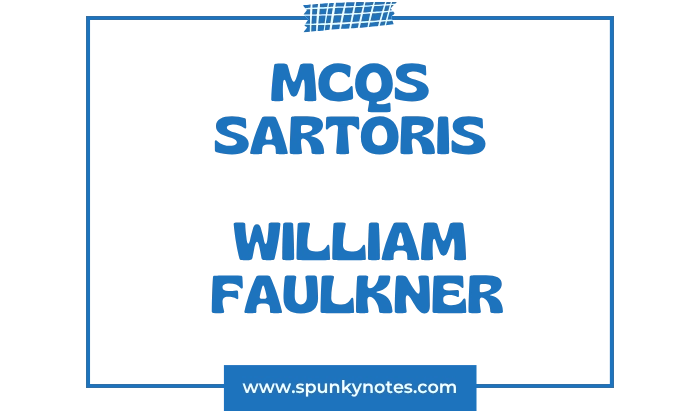

Estimated Reading Time: 16 min
Sartoris MCQs
1. Who sat with Old Bayard, the banker, in the bank office?
A. Bank cashier
B. Old Man Falls
C. Simon, the driver
D. John Sartoris
2. What item belonging to his father did Old Bayard hold?
A. Ornate carriage
B. Charred pipe bowl
C. Silver pistol
D. Army musket
3. What words were visible on the bank’s street door shade?
A. Entrance Closed
B. Bank Closed
C. Come Back Later
D. Open Tomorrow
4. What helped Old Bayard hear Simon better in the carriage?
A. Simon shouting
B. Simon’s singing
C. Carriage vibration
D. Hearing aid
5. Why did Simon complain about young Bayard’s return?
A. Looked like trash
B. Wrecked carriage
C. Sold his land
D. Ignored family
6. What was choking the wisteria vine on the veranda?
A. A locust tree
B. An ancient ivy
C. A climbing rose
D. Kudzu vine
7. How did Elnora move down the polished hall?
A. Sibilant footfalls
B. Loud stomping
C. Slow humming
D. Quiet clicking
8. What title did Carolina Bayard Sartoris hold under Jeb Stuart?
A. Colonel
B. Aide-de-Camp
C. Major General
D. Cavalry Captain
9. What reason did John Sartoris Sr. give for being killed unarmed?
A. Loved his enemy
B. Was tired of killing
C. Wanted to confess
D. Planned to flee
10. What did Aunt Jenny find diverting about General Pope?
A. His military skill
B. His plumed hat
C. His nightshirt
D. His famous horse
11. What did Stuart’s troops drink after they raided Pope’s camp?
A. Coffee
B. Cold whiskey
C. Spring water
D. Wine
12. Where was Bayard Sartoris Sr. shot by a hidden cook?
A. In the head
B. In the back
C. In the chest
D. In the legs
13. What distinct aroma did Simon bring into the dining room/office?
A. Old honeysuckle
B. Old toddy
C. Stables/horses
D. Fresh cigar smoke
14. What did Falls say about a pauper’s house and John Sartoris’ pipe?
A. It was worthless
B. Unfit for it
C. Pipe was stolen
D. Bayard wanted it
15. What filled young Bayard’s throat when he remembered his plane crash?
A. Sour smoke
B. Vomit
C. Painful scream
D. Bitter fear
16. What kind of building did the hill-man build on the beautiful lot?
A. A magnificent cabin
B. Architectural garbling
C. Small cottage
D. Stone monument
17. Why did Miss Jenny usually leave Belle Mitchell’s parties early?
A. Disliked the hostess
B. Feared the husband
C. Miss Bayard’s toddy-time
D. Had too many secrets
18. How did Narcissa appear when she joined Miss Jenny outside?
A. With grave serenity
B. With shy fear
C. With nervous anger
D. With haughty disdain
19. What item did Horace Benbow bring back that he was worried about losing?
A. His dress clothes
B. Military helmet
C. Glass-blowing box
D. New dictionary
20. What was written on Horace’s military sleeve?
A. Captain’s star
B. Service stripe
C. Triangle symbol
D. Purple Heart
21. What did Narcissa say about Shakespeare’s lack of secrets?
A. Too difficult
B. Too long
C. Tells everything
D. Too old-fashioned
22. What did Old Bayard record in the brass-bound Bible after John’s death?
A. John’s rank
B. John’s name
C. John’s virtues
D. John’s deeds
23. What ailment appeared on Old Bayard’s face?
A. A small cut
B. A reddish bruise
C. A small hard wen
D. A bad rash
24. What did Old Man Falls plan to treat the growth with?
A. Calomel
B. Axle grease
C. Quinine
D. Whiskey
25. How did Miss Jenny describe Bayard’s motivation for reckless driving?
A. Wanted to be killed
B. Wanted attention
C. Lacked sense
D. Loved speed
26. What happened when Dr. Brandt touched the wen on Old Bayard’s cheek?
A. It bled profusely
B. It fell off instantly
C. It hardened further
D. It began to sting
27. What was Dr. Alford’s main recommendation for Old Bayard’s growth?
A. Monitor its size
B. Immediate operation
C. Use Falls’ salve
D. Try a poultice
28. What did Dr. Peabody’s practice use to require besides a saw?
A. A gallon of whiskey
B. A clean shirt
C. A team of nurses
D. A ledger book
29. What was Dr. Peabody’s usual fee for services in his younger years?
A. Legal services
B. Money payment
C. Meal or corn
D. Bartering medicine
30. What did the blind beggar wear on his breast alongside the Liberty Loan button?
A. A silk cord
B. A small metal brooch
C. A Purple Heart
D. A colonel’s pin
31. What was V.K. Suratt’s job when he drove Bayard home?
A. Horse trader
B. Sewing machine agent
C. Cotton mill worker
D. Farm hand
32. What was V.K. Suratt referring to when he mentioned his throat pumping?
A. Shouting loudly
B. Drinking whiskey
C. Choking fearfully
D. Trying to sing
33. What did V.K. Suratt say was wrong with the way he learned to chop cotton?
A. Too slow a pace
B. No shoes worn
C. Row was too long
D. Hoe was dull
34. What did the MacCallum family attempt to create with their fox pups?
A. Superior guard dogs
B. Hybrid hunting dogs
C. Fox skin coats
D. Strong work animals
35. What was MacCallum’s brother Henry’s primary hobby/relaxation?
A. Fishing
B. Making whiskey
C. Card playing
D. Wood carving
36. What filled the mattress Bayard slept on in the MacCallum house?
A. Corn shucks
B. Soft feathers
C. Cotton batting
D. Sheep’s wool
37. What was the final destination of Flem Snopes after his career advancement?
A. Hotel owner
B. Bank vice president
C. City judge
D. State senator
38. What did the anonymous letter writer threaten to do if Narcissa loved a man “unholy”?
A. Tell the police
B. Kill the man
C. Start a rumor
D. Leave town forever
39. What did Narcissa do with the anonymous letters she received?
A. Showed Bayard
B. Tore them up
C. Locked them away
D. Mailed them back
40. Who wrote the anonymous letters to Narcissa?
A. Eustace Graham
B. Flem Snopes
C. Byron Snopes
D. Harry Mitchell
41. What did Horace say Belle Mitchell had asked him regarding his finances?
A. If he were working
B. If he were wealthy
C. If he had enough money
D. If he paid debts
42. What did Horace describe the glass vases he made as being like?
A. Preserved flowers
B. Ancient sculptures
C. New toys
D. Broken glass
43. What kind of fruit did Miss Jenny want Bayard to help burn in his ceremony?
A. Fig preserves
B. Peach baskets
C. Quince jelly
D. Strawberry jam
44. What was the destination Bayard and Narcissa drove toward when he drove recklessly after his recovery?
A. An abandoned farm
B. John’s grave
C. The stone bridge
D. Memphis highway
45. What did the aviator lend Bayard before his fatal test flight?
A. A flight jacket
B. A silk scarf
C. A woman’s garter
D. A diamond ring
46. What was the fatal theory behind the new plane Bayard flew?
A. External cables
B. Internal spring bracing
C. Unique engine
D. Extra fuel tanks
47. In which city was Bayard killed during his test flight?
A. San Francisco
B. Dayton
C. Chicago
D. New York
48. How did Miss Jenny describe Old Bayard’s method of dying?
A. Quietly in sleep
B. From the inside out
C. Like a true soldier
D. With great fuss
49. What was the final, chosen name for Narcissa’s baby?
A. John Sartoris
B. Bayard Du Pre
C. Benbow Sartoris
D. William Falls
50. What decorative objects bordered Simon’s grave, placed by others?
A. Plastic flowers
B. Broken crockery
C. Stone cherubs
D. Garden gnomes
Brief Overview
Sartoris is a novel by William Faulkner, published in 1929. It is a tragic story centered on the Sartoris family in the American South. The novel shows how a family’s romantic obsession with its violent, glorious past makes its present members unable to survive in the modern world.
The narrative is dominated by the memory of powerful, reckless ancestors, particularly Colonel John Sartoris, a Confederate war hero who was killed long ago. The present patriarch is Old Bayard Sartoris, a deaf, aged banker, who lives with his sharp, old great-aunt, Miss Jenny Du Pre.
Young Bayard Sartoris, the Colonel’s great-grandson, returns home from fighting in World War I. He is reckless and deeply haunted by the death of his twin brother, John, who was killed while flying in the war.
Young Bayard buys a powerful, fast car. He drives it dangerously, constantly seeking speed, violence, and destruction. Old Bayard often rides with him, deeply worried about his grandson’s self-destructive nature.
A quiet young woman, Narcissa Benbow, becomes close to the family. She is disturbed by Bayard’s behavior and tries unsuccessfully to stabilize him.
Bayard’s recklessness culminates in tragedy: Old Bayard dies suddenly while riding in the car with him. Following this, young Bayard travels abroad, continuing to seek danger. He eventually dies in an airplane crash, fulfilling the family’s traditional, violent fate. Narcissa later gives birth to his son. She names the child Benbow Sartoris, hoping that giving him a new name will protect him from the family’s destructive legacy.


